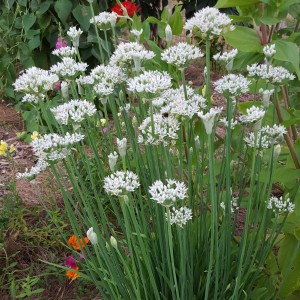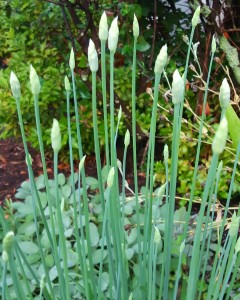 Garlic chives (Allium tuberosum) are one of my favorite end of summer flowers. Their airy white flowers are the perfect foil for the darker autumnal colors that are coming. It doesn’t hurt that garlic chives are also edible, with the onion flavor of their relatives the chives (A. schoenoprasum) along with a distinctive hint of garlic. Garlic chives are widely used in Asian cuisines where it is known by many names including Chinese leeks and Chinese chives.
Garlic chives (Allium tuberosum) are one of my favorite end of summer flowers. Their airy white flowers are the perfect foil for the darker autumnal colors that are coming. It doesn’t hurt that garlic chives are also edible, with the onion flavor of their relatives the chives (A. schoenoprasum) along with a distinctive hint of garlic. Garlic chives are widely used in Asian cuisines where it is known by many names including Chinese leeks and Chinese chives.
Garlic chives are native to the Himalayan region of India, Nepal and Bhutan, including the adjacent Chinese province. They have become naturalized in many parts of the world. Here in the US they are hardy in zones 4 through 10. In warmer zones, 8 through 10, they remain green year round. In colder zones, the foliage dies to the ground in the fall and re-emerges in the spring. The plants grow from underground rhizomes but also reproduce by self-sown seeds. In some areas, they have become invasive so you might want to deadhead the plants.

Garlic Chives Buds
In Asia, garlic chives are grown for culinary purposes. Both the leaves and the unopened flower buds are used in cooking. Here in the US, garlic chives are grown mainly as ornamentals. The white, umbel shaped flowers appear in late summer.
Plant your garlic chives in full sun in well-drained soil. They can also be grown in containers. Like chives, the plants look like small grasses but whereas chives have rounded leaves, garlic chive leaves are flat and approximately 12- to 18-inches tall. The plants grow in bunches like grasses. The bunches should be divided every 3 to 4 years to keep them healthy.
You can start plants from divisions or grow them from seeds. Direct sow the seeds in your garden when the soil has warmed to 60⁰F. Plant them ¼ inch deep. To start seeds indoors, sow them ¼ inch deep 6 to 8 weeks before your last frost. Germination should occur within 1 to 2 weeks. You can transplant your seedlings into your garden once the soil has warmed and all danger of frost has passed.
Harvesting of the leaves can begin once the plants are established but before flowering. Cut the leaves off at ground level. Harvesting can be done 3 to 4 times per year. The leaves can be used fresh or dried. To dry the leaves, gather in bunches and cut them into ¼- to ½-inch pieces. Dry the pieces on a screen in a dark, well-ventilated space, stirring them occasionally or you can use a food dehydrator.

